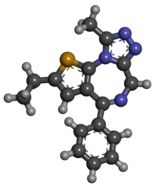Deschloroetizolam
Source: Wikipedia, the free encyclopedia.
Chemical compound
 | |
 | |
| Clinical data | |
|---|---|
| Dependence liability | Moderate |
| Routes of administration | Oral, sublingual, rectal |
| Legal status | |
| Legal status | |
| Identifiers | |
| |
JSmol) | |
| |
| |
Deschloroetizolam (also known as Etizolam-2) is a thienotriazolodiazepine that is the dechlorinated analog of the closely related etizolam.[1][2][3] The compound has been sold as a designer drug.[4][5][6][7]
Legal status
Deschloroetizolam is classified and controlled as a hazardous substance in Sweden as of on October 15, 2015.[8]
See also
- Adinazolam
- Clonazolam
- Deschloroclotizolam
- Diclazepam
- Etizolam
- Flubromazepam
- Flubromazolam
- Fluetizolam
- Meclonazepam
- Metizolam
- Nifoxipam
- Pyrazolam
References
- .
- ^ US 3904641, Nakanishi M, Tahara T, Araki K, Shiroki M, "Triazolothienodiazepine compounds", published 1975-09-09, assigned to Yoshitomi Pharmaceutical Industries, Ltd.
- ^ EP 0776892, Hiroshi K, Syuji E, Hideaki S, Minoru M, Kenichi O, "Thienylazole compound and thienotriazolodiazepine compound", published 4 June 1997, assigned to Yoshitomi Pharmaceutical Industries, Ltd.
- ^ "Deschloroetizolam". New Synthetic Drugs Database. 9 November 2023.
- PMID 27366870.
- S2CID 31098917.
- S2CID 247455284.
- ^ "Nya substanser klassas som narkotika eller hälsofarlig vara" (in Swedish). Folkhälsomyndigheten. 18 August 2015.
